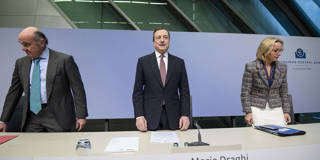The fact that eurozone inflation is closer to 1% than 2% is not ideal, but the European Central Bank should not be overly concerned. The ECB does not need to pull out all the stops and invent ever more instruments in the forlorn hope of increasing inflation by a few tenths of a percentage point.
BRUSSELS – A year ago, the European Central Bank took advantage of a temporary uptick in prices to declare victory in its fight to bring eurozone inflation up to its target of “below, but close to, 2%.” But the triumph proved short-lived. Headline inflation has since come down again, and core inflation, which strips out volatile energy prices, is back to about 1%. Yet this should not be a major concern for the ECB.
The ECB’s staff projections still see eurozone inflation reaching close to 2% by 2021-2022. But, having wrongly predicted a pickup in inflation for the past several years, these forecasts now have little credibility. This is apparent in financial-market expectations of eurozone inflation as measured by so-called inflation swap rates, which are stuck below 1% even five years into the future. And markets predict that euro-area inflation will still be below 1.5% a decade from now.
This puts the ECB in a quandary. The eurozone economy is weakening, which might further diminish inflationary pressures. But the ECB does not dare to restart its sovereign bond-buying program with the aim of providing additional economic stimulus, because national central banks in the eurozone already hold large amounts of their own governments’ bonds. Making these central banks buy even more would put them in a very difficult position if any government were to experience financial stress. This is why the ECB has so far limited itself to announcing that it will continue to provide commercial banks with longer-term, three-year financing at ultra-low rates.

BRUSSELS – A year ago, the European Central Bank took advantage of a temporary uptick in prices to declare victory in its fight to bring eurozone inflation up to its target of “below, but close to, 2%.” But the triumph proved short-lived. Headline inflation has since come down again, and core inflation, which strips out volatile energy prices, is back to about 1%. Yet this should not be a major concern for the ECB.
The ECB’s staff projections still see eurozone inflation reaching close to 2% by 2021-2022. But, having wrongly predicted a pickup in inflation for the past several years, these forecasts now have little credibility. This is apparent in financial-market expectations of eurozone inflation as measured by so-called inflation swap rates, which are stuck below 1% even five years into the future. And markets predict that euro-area inflation will still be below 1.5% a decade from now.
This puts the ECB in a quandary. The eurozone economy is weakening, which might further diminish inflationary pressures. But the ECB does not dare to restart its sovereign bond-buying program with the aim of providing additional economic stimulus, because national central banks in the eurozone already hold large amounts of their own governments’ bonds. Making these central banks buy even more would put them in a very difficult position if any government were to experience financial stress. This is why the ECB has so far limited itself to announcing that it will continue to provide commercial banks with longer-term, three-year financing at ultra-low rates.